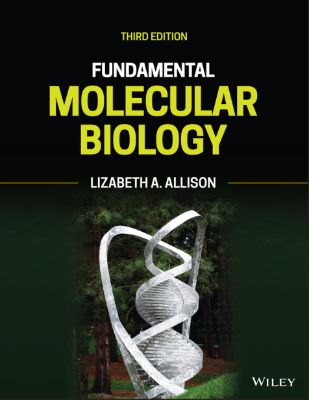Fundamental Molecular Biology

Námskeið
- LEI603G Sameindaerfðafræði
.
Ensk lýsing:
N/ALýsing:
While there is an innate fascination and interest in how our own genes influence our lives, molecular biology students are daunted by the amount of information they need to assimilate in order to succeed in the course. And, with the fast pace of discovery in the field, it is difficult to find suitable, up to date texts for the course-they are either too advanced, comprehensive and overwhelming detailed, or they are too basic, superficial, and less experimental in their approach.
Instructors find it difficult to decide what topics are the most important to include and exclude in the course when presented with an extensive array of choices. Fundamental Molecular Biology is selective in its coverage and presents essential topics that allow students to develop an understanding of how molecular biology is applied to the analysis of complex systems. Through the process of discovery-- observations, questions, experimental designs, results and conclusions-and with an emphasis on the language of molecular biology, students can focus on the key ideas they need to succeed in the course.
Students will also have the support they need outside the classroom to leave your course knowing the core, fundamental concepts of molecular biology delivered through a visually engaging, and focused text with a rich media program that promotes self-study. With a strong emphasis on biomedical research and discovery, students are exposed to both classic and the most up to date techniques and research in molecular biology today.
Annað
- Höfundur: Lizabeth A. Allison
- Útgáfa:3
- Útgáfudagur: 2021-04-21
- Hægt að prenta út 10 bls.
- Hægt að afrita 2 bls.
- Format:ePub
- ISBN 13: 9781119156321
- Print ISBN: 9781119156291
- ISBN 10: 1119156327
Efnisyfirlit
- Cover
- Title Page
- Copyright
- ABOUT THE COMPANION WEBSITE
- CHAPTER ONE: The Beginnings of Molecular Biology
- 1.1 Introduction
- 1.2 Insights into the nature of the hereditary material
- 1.3 A model for the structure of DNA: The DNA double helix
- 1.4 The central dogma of molecular biology
- 1.5 An evolutionary framework for heredity
- BIBLIOGRAPHY
- CHAPTER TWO: The Structure of DNA
- 2.1 Introduction
- 2.2 Primary structure: the components of nucleic acids
- 2.3 Secondary structure of DNA
- 2.4 Unusual DNA secondary structures
- 2.5 Tertiary structure of DNA
- BIBLIOGRAPHY
- CHAPTER THREE: The Versatility of RNA
- 3.1 Introduction
- 3.2 RNA is involved in a wide range of cellular processes
- 3.3 Structural motifs of RNA
- 3.4 The discovery of RNA catalysis
- 3.5 RNA‐based genomes
- BIBLIOGRAPHY
- CHAPTER FOUR: Protein Structure and Folding
- 4.1 Introduction
- 4.2 Primary structure: amino acids and the genetic code
- 4.3 The three‐dimensional structure of proteins
- 4.4 Protein function and regulation of activity
- 4.5 Protein folding and misfolding
- BIBLIOGRAPHY
- CHAPTER FIVE: Genome Organization and Evolution
- 5.1 Introduction
- 5.2 Genome organization varies in different organisms
- 5.3 Packaging of the eukaryotic genome
- 5.4 The majority of the eukaryotic genome is noncoding
- 5.5 Lateral gene transfer contributes to genome evolution
- 5.6 Prokaryotic and viral genome organization
- BIBLIOGRAPHY
- CHAPTER SIX: DNA Replication and Telomere Maintenance
- 6.1 Introduction
- 6.2 Early insights into the mode of bacterial DNA replication
- 6.3 DNA polymerases are the enzymes that catalyze DNA synthesis from 5′ to 3′
- 6.4 The bacterial replisome
- 6.5 The eukaryotic replisome
- 6.6 Alternative modes of circular DNA replication
- 6.7 Telomere maintenance: the role of telomerase in DNA replication, aging, and cancer
- BIBLIOGRAPHY
- CHAPTER SEVEN: DNA Repair Pathways
- 7.1 Introduction
- 7.2 Mutations and DNA damage
- 7.3 Lesion bypass
- 7.4 Direct reversal of DNA damage
- 7.5 Repair of single base changes and structural distortions by removal of DNA damage
- 7.6 Double‐strand break repair by removal of DNA damage
- BIBLIOGRAPHY
- CHAPTER EIGHT: Transcription in Bacteria
- 8.1 Introduction
- 8.2 Mechanism of transcription
- 8.3 Insights into gene regulation from the lactose (lac) operon
- 8.4 Mode of action of transcriptional regulators
- 8.5 Control of gene expression by RNA
- 8.6 Gene regulatory networks
- BIBLIOGRAPHY
- CHAPTER NINE: Transcription in Eukaryotes
- 9.1 Introduction
- 9.2 Overview of transcriptional regulation
- 9.3 Protein‐coding gene regulatory elements
- 9.4 The general transcription machinery and mechanism of transcription
- 9.5 The role of specific transcription factors in gene regulation
- 9.6 Transcriptional coactivators and corepressors
- 9.7 Transcription complex assembly: the enhanceosome model versus the “hit‐and‐run” model
- 9.8 Regulated nuclear import and export of transcription factors
- BIBLIOGRAPHY
- CHAPTER TEN: Epigenetic Mechanisms of Gene Regulation
- 10.1 Introduction
- 10.2 Epigenetic markers
- 10.3 Genomic imprinting
- 10.4 X chromosome inactivation
- 10.5 Epigenetic control of transposable elements
- 10.6 Epigenetics and nutritional legacy
- 10.7 Allelic exclusion
- BIBLIOGRAPHY
- CHAPTER ELEVEN: RNA Processing and Posttranscriptional Gene Regulation
- 11.1 Introduction
- 11.2 The discovery of split genes
- 11.3 Splicing occurs by a variety of mechanisms
- 11.4 Cotranscriptional processing of nuclear pre‐mRNA
- 11.5 Alternative splicing
- 11.6 RNA editing
- 11.7 Post‐transcriptional gene regulation by RNAi
- 11.8 RNA turnover in the nucleus and cytoplasm
- BIBLIOGRAPHY
- CHAPTER TWELVE: The Mechanism of Translation
- 12.1 Introduction
- 12.2 Ribosome structure and assembly
- 12.3 Aminoacyl‐tRNA synthetases
- 12.4 Initiation of translation
- 12.5 Elongation and events in the ribosome tunnel
- 12.6 Termination of translation
- 12.7 Translational and post‐translational control
- BIBLIOGRAPHY
- CHAPTER THIRTEEN: Recombinant DNA Technology and Genetically Modified Organisms
- 13.1 Introduction
- 13.2 The beginnings of recombinant DNA technology
- 13.3 Cutting and joining DNA
- 13.4 Molecular cloning
- 13.5 Library screening and probes
- 13.6 Restriction mapping and RFLP analysis
- 13.7 DNA sequencing
- 13.8 Introduction to genetically modified organisms
- 13.9 Transgenic mice: pronuclear microinjection
- 13.10 Gene targeting in mouse embryonic stem cells
- 13.11 CRISPR‐Cas gene editing
- 13.12 Applications of genetically modified animals
- 13.13 Cloning by nuclear transfer
- 13.14 Transgenic plants
- BIBLIOGRAPHY
- CHAPTER FOURTEEN: Tools for Analyzing Gene Organization, Expression, and Function
- 14.1 Introduction
- 14.2 DNA typing
- 14.3 Genomics, proteomics, and beyond
- 14.4 Whole‐genome sequencing
- 14.5 Reporter genes
- 14.6 Transcriptomics: RNA expression and localization
- 14.7 Proteomics: protein expression and localization
- 14.8 Analysis of nucleic acid–protein interactions
- 14.9 Analysis of protein–protein interactions
- 14.10 Structural analysis of proteins
- BIBLIOGRAPHY
- CHAPTER FIFTEEN: Medical Molecular Biology
- 15.1 Introduction
- 15.2 Genomic medicine
- 15.3 Molecular biology of cancer
- 15.4 Gene therapy
- BIBLIOGRAPHY
- APPENDIX
- Chapter 1
- Chapter 2
- Chapter 3
- Chapter 4
- Chapter 5
- Chapter 6
- Chapter 7
- Chapter 8
- Chapter 9
- Chapter 10
- Chapter 11
- Chapter 12
- Chapter 13
- Chapter 14
- Chapter 15
- GLOSSARY
- Index
- End User License Agreement
UM RAFBÆKUR Á HEIMKAUP.IS
Bókahillan þín er þitt svæði og þar eru bækurnar þínar geymdar. Þú kemst í bókahilluna þína hvar og hvenær sem er í tölvu eða snjalltæki. Einfalt og þægilegt!Rafbók til eignar
Rafbók til eignar þarf að hlaða niður á þau tæki sem þú vilt nota innan eins árs frá því bókin er keypt.
Þú kemst í bækurnar hvar sem er
Þú getur nálgast allar raf(skóla)bækurnar þínar á einu augabragði, hvar og hvenær sem er í bókahillunni þinni. Engin taska, enginn kyndill og ekkert vesen (hvað þá yfirvigt).
Auðvelt að fletta og leita
Þú getur flakkað milli síðna og kafla eins og þér hentar best og farið beint í ákveðna kafla úr efnisyfirlitinu. Í leitinni finnur þú orð, kafla eða síður í einum smelli.
Glósur og yfirstrikanir
Þú getur auðkennt textabrot með mismunandi litum og skrifað glósur að vild í rafbókina. Þú getur jafnvel séð glósur og yfirstrikanir hjá bekkjarsystkinum og kennara ef þeir leyfa það. Allt á einum stað.
Hvað viltu sjá? / Þú ræður hvernig síðan lítur út
Þú lagar síðuna að þínum þörfum. Stækkaðu eða minnkaðu myndir og texta með multi-level zoom til að sjá síðuna eins og þér hentar best í þínu námi.
Fleiri góðir kostir
- Þú getur prentað síður úr bókinni (innan þeirra marka sem útgefandinn setur)
- Möguleiki á tengingu við annað stafrænt og gagnvirkt efni, svo sem myndbönd eða spurningar úr efninu
- Auðvelt að afrita og líma efni/texta fyrir t.d. heimaverkefni eða ritgerðir
- Styður tækni sem hjálpar nemendum með sjón- eða heyrnarskerðingu
- Gerð : 208
- Höfundur : 5662
- Útgáfuár : 2011
- Leyfi : 380


